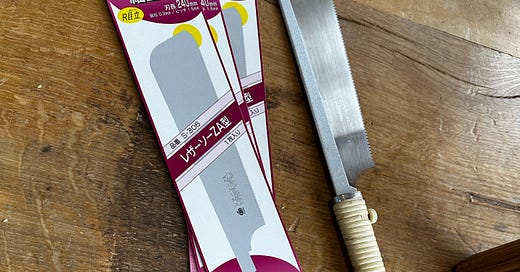For my 30th birthday, my wife bought me a beautiful handmade Dozuki from the now-defunct Japan Woodworker. It was a beautiful saw, and a big step up from the plastic-handled Ryboas and Dozukis I’d been using in the shop.
After a few test cuts, I started cutting some dovetails for a clock case I was working on in white oak. The saw cut smoothly. But after a few strokes, I heard “plink, plink, plink.” The teeth were breaking off. I lost about six or seven in one stroke.
Dismayed, I called Japan Woodworker. Their answer: You were not smart to use that saw in white oak or any American ring-porous wood.1
We got into it a little bit, and they agreed to send me a replacement. Since then, I’ve been wary of handmade Japanese saws. It doesn’t take much error to kink them or destroy their teeth.
These days I use mostly Western saws because they can take more abuse. But I still use a couple Japanese saws in my work. Of these, the Gyokucho 306 Razorsaw is my hands-down favorite. It cuts as well as any high-end Japanese saw I’ve used (though I am not a connoisseur). And the blade is replaceable.
So if the blade kinks or the teeth break, it’s a $13 problem – not a $300 problem.
The saw has 17 teeth per inch with a blade that is 9-1/4” long and 0.01” thick. It glides through American hardwoods and softwoods with no complaint. I go through about a blade a year, but that’s mostly because students kink it occasionally. If you are careful, a blade can last a lot longer.
When I first started using the saw, some fellow woodworkers shamed me for using a saw with a replaceable blade. “Why use a saw with a blade you throw away? Seems wasteful.”
Keep reading with a 7-day free trial
Subscribe to Never Sponsored to keep reading this post and get 7 days of free access to the full post archives.





